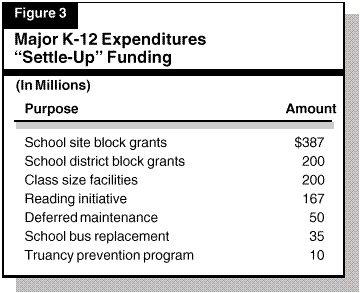
 |
State Spending Plan for 1996-97
|
This chapter provides a description of the major features of the 1996-97 budget plan. It includes individual discussions of the budget actions within each of the major program areas, as well as discussion of the budget actions that affect revenues.
Figure 1 summarizes for 1995-96 and 1996-97 the effect of the budget package on K-12 schools, community colleges, and other specified agencies. The budget proposes $29.1 billion for Proposition 98 in 1996-97. This represents an increase of $1.7 billion, or 6 percent, from the revised 1995-96 funding level. Almost all of this increase is from the state General Fund because local property taxes are projected to increase only slightly in 1996-97.

Proposition 98 funding for K-12 schools totals $25.9 billion. This represents an increase of $2.5 billion, or 11 percent, from the funding level included in the 1995 Budget Act. This large increase results from two sources. First, the 1995-96 minimum funding guarantee increased from the budgeted level by $1.1 billion due to higher-than-anticipated General Fund revenues. Second, the budget assumes the 1996-97 K-12 share of Proposition 98 funds will increase by $1.4 billion, or 5.9 percent. As a result, a total of $2.5 billion in new funds is included in the 1996 Budget Act for K-12 education.
As Figure 1 also shows, community college funding in 1996-97 increases by $170 million from the revised 1995-96 level. We discuss the community colleges' budget in the higher education section of this report.
The budget allocates the remaining $1.3 billion for other purposes, including new programs and existing K-12 categorical programs. Figure 2 displays the major K-12 Proposition 98 appropriations for 1996-97.
Class-Size Reduction. The budget dedicates a major portion of the remaining funds to provide $771 million to reduce class sizes in kindergarten through grade three. The features of this new program are as follows:
Other 1996-97 Initiatives. As Figure 2 illustrates, the budget contains a number of other program increases. The budget includes an additional $178 million for revenue limit increases ($147 million to equalize school district revenue limits and $31 million for general revenue limit increases). Chapter 203, Statutes of 1996 (AB 3497, Richter) contains the statutory changes needed to implement the equalization provisions. The enacted bill also contains a provision that directs the use of any additional Proposition 98 funds that may become available during the year. It provides that additional funds shall be used to provide further increases in revenue limit equalization (50 percent) and across-the-board increases in district revenue limits (50 percent).

1995-96 and Prior Years Settle-Up Funding. Proposition 98's minimum funding levels are determined by one of four specified formulas, each using a set of specified factors. Because the factors change during the year, the minimum funding guarantee under Proposition 98 also changes during the year. Any additional amount needed to fund any increase in the guarantee is referred to as Proposition 98 "settle-up" funding.
The budget contains approximately $1.3 billion in settle-up funding for K-12 programs. Figure 3 (next page) displays the major allocations of these monies. The Legislature appropriated most of these funds for one-time activities. More than half of the one-time funds were distributed in the form of local block grants. Specifically, the budget allocates a total of $387 million in block grants to local school sites for one-time expenditures. Each school will receive about $70 per student, with no school receiving less than $25,000. In addition, the budget provides $200 million in block grants to school districts. Under these grants, each district will receive about $37 per student.
As Figure 3 illustrates, the budget also includes $200 million to provide support for "portable" classrooms that districts will need in order to reduce class sizes in the primary grades. The budget specifies that schools will receive $25,000 per portable. Therefore, this funding is sufficient to purchase about 8,000 new classrooms. The budget also appropriates $167 million for a reading initiative. Of this amount, $152 million is for new instructional materials, $13 million is for staff development, and $2 million is for district leadership training.


The Legislature approved a budget plan for the UC that includes:
The Legislature approved a budget plan for the CSU that includes:
1996-97 Expenditures. Figure 5 illustrates the major program increases provided with the additional funds in 1996-97. The budget includes $54 million to fund additional enrollment growth at new centers ($20 million) and new facilities at existing campuses ($24 million). These centers and facilities had been built during the early 1990s but never received additional funding for growth in student attendance. The total of $54 million also includes additional maintenance funding for these centers and facilities ($10 million).

Vetoed Funds. The Governor vetoed $26 million included in
the Budget Bill for program improvement. Senate Bill 1233
(Costa), which was passed by the Legislature at the end of the
session, instead would appropriate $25.6 million for additional
apportionments growth funding in
1996-97. This would bring apportionments growth funding in
the 1996-97 budget to a total of $63.5 million.
Settle-Up Expenditures. The budget includes $166 million in settle-up funding for four one-time activities. Of this amount, the budget allocates $75 million for district block grants, which will be allocated on a per-student basis. The budget also provides $60 million to increase support for deferred maintenance and $20 million for removing architectural barriers to disabled persons. Finally, the budget contains $9.4 million to provide funding that was lost in 1995-96 when property tax revenues to community colleges were lower than expected.